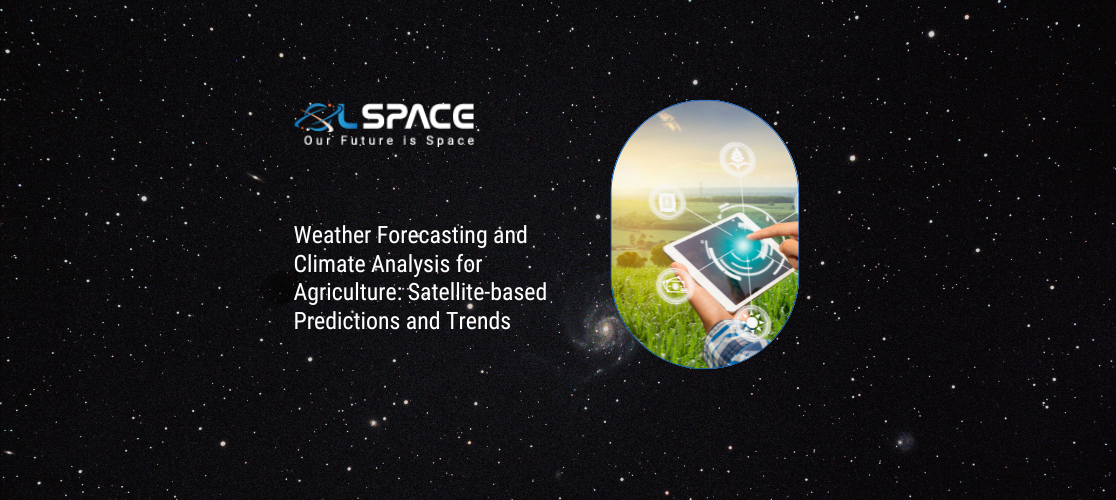14 July 2023
Weather Forecasting and Climate Analysis for Agriculture: Satellite-based Predictions and Trends

Weather conditions and climate patterns play a vital role in agricultural planning and decision-making. Accurate weather forecasting and climate analysis provide valuable insights to farmers, enabling them to optimise crop management, irrigation, pest control, and harvesting strategies. In recent years, satellite-based technologies have revolutionised weather forecasting and climate analysis, offering farmers real-time data and predictions to enhance agricultural practices. In this blog post, we will explore the benefits and applications of satellite-based weather forecasting and climate analysis in agriculture.
Real-Time Weather Monitoring: Satellite-based weather forecasting systems provide real-time monitoring of weather conditions on a regional or global scale. By capturing and analysing data from weather satellites, farmers can access up-to-date information about temperature, precipitation, wind speed, humidity, and other relevant meteorological parameters. This real-time monitoring allows farmers to make timely decisions regarding irrigation, fertilisation, planting, and harvesting based on accurate weather data, minimising risks and optimising crop yield.
Precise Weather Forecasting: Satellite-based weather forecasting systems utilise advanced algorithms and modeling techniques to generate precise weather forecasts. These forecasts can predict short-term weather patterns, such as daily or weekly forecasts, as well as long-term climate trends. Farmers can leverage this information to plan their agricultural activities accordingly, such as scheduling planting and harvesting dates, optimising irrigation schedules, and protecting crops from adverse weather conditions. Precise weather forecasting helps farmers mitigate risks, optimise resource utilisation, and improve overall farm productivity.
Early Warning Systems: Satellite-based weather forecasting systems can provide early warning systems for extreme weather events such as storms, hurricanes, or droughts. These systems can detect the formation and movement of weather systems, enabling farmers to prepare and implement appropriate measures to protect their crops and livestock. Early warnings allow farmers to take preventive actions, such as reinforcing structures, securing equipment, or adjusting cultivation practices to minimise the potential impact of extreme weather events. By receiving timely alerts, farmers can reduce crop loss, enhance safety, and protect their investments.
Climate Analysis and Trends: Satellite-based climate analysis provides valuable insights into long-term climate trends and patterns. By analysing historical data collected by weather satellites, scientists and researchers can identify climate trends, such as temperature changes, precipitation patterns, or shifts in growing seasons. This information helps farmers make informed decisions about crop selection, adapt to changing climatic conditions, and implement strategies for climate resilience. Climate analysis also supports long-term planning and policy-making in agriculture, contributing to sustainable farming practices and resource management.
Precision Agriculture and Resource Optimisation: Satellite-based weather forecasting and climate analysis contribute to the implementation of precision agriculture techniques. By integrating weather data with geographic information systems (GIS) and sensor technologies, farmers can optimise resource utilisation, such as water, fertilisers, and pesticides. Real-time weather data helps farmers determine optimal irrigation schedules, prevent water stress, and minimise the risk of over or under-application of agricultural inputs. By fine-tuning their practices based on weather and climate information, farmers can improve resource efficiency, reduce environmental impacts, and increase overall productivity.
Decision Support Systems: Satellite-based weather forecasting and climate analysis systems often integrate with decision support systems (DSS). These DSS platforms provide farmers with user-friendly interfaces and tools to interpret weather data, access customised recommendations, and make informed decisions. DSS platforms may offer features such as crop-specific advisories, disease and pest risk assessments, and yield forecasts based on weather and climate data. By utilising these systems, farmers can optimise their decision-making process, improve productivity, and reduce potential losses.
Conclusion: Satellite-based weather forecasting and climate analysis have revolutionised the agricultural sector by providing farmers with real-time weather data, precise forecasts, and valuable insights into climate trends. By leveraging these technologies, farmers can make informed decisions regarding crop management, resource utilisation, and risk mitigation. The integration of satellite-based weather data with precision agriculture techniques and decision support systems enables farmers to optimise their practices, increase productivity, and adapt to changing climatic conditions. Embracing satellite-based weather forecasting and climate analysis in agriculture facilitates sustainable farming practices, supports resilience, and contributes to food security in a rapidly changing environment.
Join our community and never miss an update! Subscribe to our newsletter and blog to stay up-to-date on the latest trends, tips, and insights in your area of interest. Don’t miss out on exclusive content and promotions. Sign up now and be a part of our growing community!
